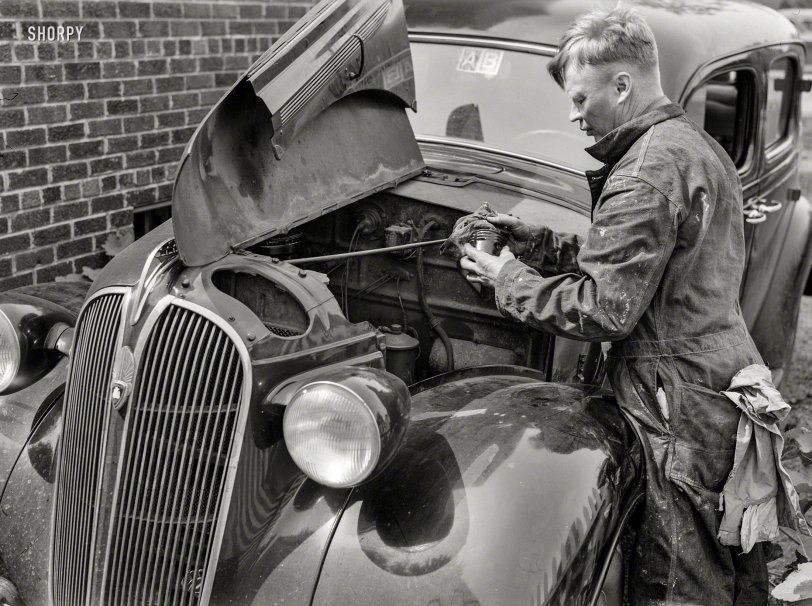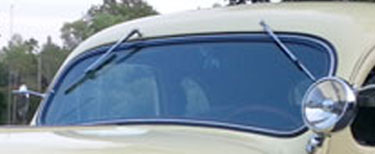


Framed or unframed, desk size to sofa size, printed by us in Arizona and Alabama since 2007. Explore now.
Shorpy is funded by you. Patreon contributors get an ad-free experience.
Learn more.

- Freeze Frame
- Texas Flyer wanted
- Just a Year Too Soon
- WWII -- Replacing men with women at the railroad crossing.
- Yes, Icing
- You kids drive me nuts!
- NOT An Easy Job
- I wonder
- Just add window boxes
- Icing Platform?
- Indiana Harbor Belt abides
- Freezing haze
- Corrections (for those who care)
- C&NW at Nelson
- Fallen Flags
- A dangerous job made worse
- Water Stop
- Passenger trains have right of way over freights?
- Coal
- Never ceases to amaze me.
- Still chuggin' (in model form)
- Great shot
- Westerly Breeze
- For the men, a trapeze
- Tickled
- Sense of loneliness ...
- 2 cents
- Charm City
- What an Outrage
- Brighton Park
Print Emporium
D'Oily Car: 1943

June 1943. Silver Spring, Md. "Man repairing his automobile." The Plymouth seen here. Photo by Ann Rosener, Office of War Information. View full size.
Pieces and parts
Diggr is correct that the object behind the left headlight is the oil filter. The part in the man's hands is the oil filler cap.
An oil bath breather didn't force air through oil but rather made the air make a sharp turn just above the surface of the oil in the hopes that the larger dust and debris would get stuck in the oil.
Re: oil bath air filter
The cylinder behind the left headlight is most likely the oil filter. The fitting at the top is either the inlet or exit. There was another fitting on the bottom of the can.
The oil bath air filter is over on the right side of the engine, only barely visible under the right side hood.
Gas rationing windshield stickers
Drivers who used their cars for work that was deemed essential to the war effort were classified differently and received additional stamps. There were five classifications:
Class A drivers were allowed only 3 gallons of gasoline per week.
Class B drivers (factory workers, traveling salesmen) received 8 gallons per week.
Class C drivers included essential war workers, police, doctors and letter carriers.
Class T included all truck drivers.
Class X was reserved for politicians and other “important people.”
(from the "Wired" website...)
Our driver was obviously NOT the Mikado, or a truck driver or even The Lord High Executioner! (Most likely a 'cheap tailor'!)
I remember the ration stamps, even though I was a child during the war. My mother never complained in front of me, but I remember that she burned the remainders after the war, saying 'good riddance'.
Wipers
One is hidden by the hood, the other by his head.

A mystery windshield?
Where are the windshield wipers??
Oil bath air filter
The canister type object behind the left head light may be the air filter. Instead of a paper element the carb would draw the air through oil, and you would change out the oil the same time as the motor oil. They didn't work that well, especially in the winter when the oil viscosity went up. I had a 1955 Chev with one.
For That Title
... you get "pun of the day" and a 10-second running start.
I'm the very model of the modern motor mechanic
A wand'ring mechanic I
a thing of shreds and patches.
Doing His Part!
Looks like he has his A and B gas rationing stickers displayed.
Quaker State
My guess is he's changing the oil in his flat-head six and wiping down the oil filler cap. I once used a roll of toilet tissue as an oil filter on a flat six and it did just fine. For awhile.
Breather cap?
Is that the oil breather cap (part of the crankcase ventilation system) he's holding? It's got vents on it, so it's not an oil filter. Plus, it looks like I see a cartridge type oil filter (with a banjo fitting on top) directly behind the left headlight. The rectangular box on the firewall is the voltage regulator, for the generator.
In the days before positive crankcase ventilation (PCV), cars used a breather cap to allow fresh air into the crankcase. A road draft tube ran down one side of the engine, allowing any combustion gases that got past the piston rings and into the crankcase ("blowby") to be released into the atmosphere. Once closed PCV systems came along in the '60s, the draft tube was eliminated, and blowby was drawn by engine vacuum through a PCV valve, or a metered orifice (like on Corvairs) into the air cleaner, to be recycled into the combustion process.
The 1937 Plymouth brochure can be found here.
























On Shorpy:
Today’s Top 5